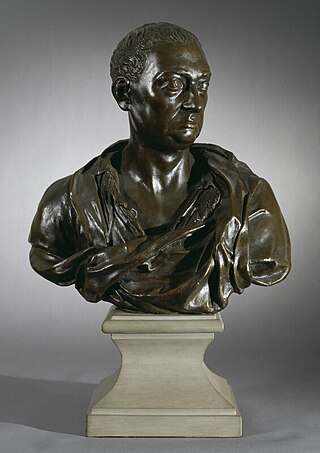| |||
|---|---|---|---|
| Buildings and structures +... |
The year 1704 in architecture involved some significant events.
Contents


| |||
|---|---|---|---|
| Buildings and structures +... |
The year 1704 in architecture involved some significant events.



Nicholas Hawksmoor was an English architect. He was a leading figure of the English Baroque style of architecture in the late-seventeenth and early-eighteenth centuries. Hawksmoor worked alongside the principal architects of the time, Christopher Wren and John Vanbrugh, and contributed to the design of some of the most notable buildings of the period, including St Paul's Cathedral, Wren's City of London churches, Greenwich Hospital, Blenheim Palace and Castle Howard. Part of his work has been correctly attributed to him only relatively recently, and his influence has reached several poets and authors of the twentieth century.

Blenheim Palace is a country house in Woodstock, Oxfordshire, England. It is the seat of the Dukes of Marlborough. Originally called Blenheim Castle, it has been known as Blenheim Palace since the 19th century. One of England's largest houses, it was built between 1705 and 1722, and designated a UNESCO World Heritage Site in 1987.

Sir John Vanbrugh was an English architect, dramatist and herald, perhaps best known as the designer of Blenheim Palace and Castle Howard. He wrote two argumentative and outspoken Restoration comedies, The Relapse (1696) and The Provoked Wife (1697), which have become enduring stage favourites but originally occasioned much controversy. He was knighted in 1714.
This article contains information about the literary events and publications of 1704.
This article contains information about the literary events and publications of 1705.

Greenwich Hospital was a permanent home for retired sailors of the Royal Navy, which operated from 1692 to 1869. Its buildings, initially Greenwich Palace, in Greenwich, London, were later used by the Royal Naval College, Greenwich and the University of Greenwich, and are now known as the Old Royal Naval College. The word "hospital" was used in its original sense of a place providing hospitality for those in need of it, and did not refer to medical care, although the buildings included an infirmary which, after Greenwich Hospital closed, operated as Dreadnought Seaman's Hospital until 1986.
The year 1752 in architecture involved some significant events.

The year 1754 in architecture involved some significant events.

Ludwigsburg Palace, nicknamed the "Versailles of Swabia", is a 452-room palace complex of 18 buildings located in Ludwigsburg, Baden-Württemberg, Germany. Its total area, including the gardens, is 32 ha – the largest palatial estate in the country. The palace has four wings: the northern wing, the Alter Hauptbau, is the oldest and was used as a residence of the Duke of Württemberg; the east and west wings were used for court purposes and housing guests and courtiers; the southern wing, the Neuer Hauptbau, was built to house more court functions and was later used as a residence.
Sir Edward Lovett Pearce was an Irish architect, and the chief exponent of Palladianism in Ireland. He is thought to have initially studied as an architect under his father's first cousin, Sir John Vanbrugh. He is best known for the Irish Houses of Parliament in Dublin, and his work on Castletown House. The architectural concepts he employed on both civic and private buildings were to change the face of architecture in Ireland. He could be described as the father of Irish Palladian architecture and Georgian Dublin.

Thomas Archer (1668–1743) was an English Baroque architect. His buildings are important as the only ones by an English Baroque architect to show evidence of study of contemporary continental, namely Italian, architecture.
The year 1705 in architecture involved some significant events.
The year 1722 in architecture involved some significant events.
The year 1766 in architecture involved some significant events.
Events from the year 1705 in England.
Events from the year 1664 in England.
Events from the year 1704 in England.

Isaac Ware (1704—1766) was an English architect and translator of Italian Renaissance architect Andrea Palladio.